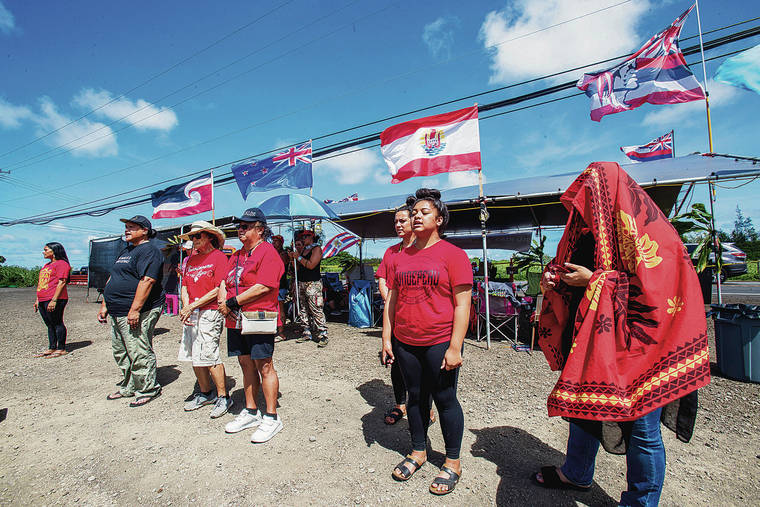Opponents of the construction of eight wind
turbines in Kahuku are
preparing for a drawn-out fight against the project, which they say will have
detrimental health effects for residents and farmers
of the rural town.
Protesters, who include those from the Ku Kia‘i Kahuku group, have set up
two tented areas along Kamehameha Highway in Kahuku, on either side of the road leading to the project site of the Na Pua Makani wind farm, a project by
Virginia-based AES Corp.
The tents on the Kahuku side of the road have stacks of water bottles, several tables with food, a keiki tent and even a massage area. On the side toward Sunset Beach is a line of tents for kupuna in front of a parking lot area where construction workers have some of their vehicles.
The entrance for normal-sized vehicles is unobstructed. But the wider parking lot entrance next
to that entrance is being blocked by the kupuna tents.
One kupuna on site who wanted to remain anonymous said she would block the way if a truck carrying a turbine part tried to get in.
Activists against the project don’t plan on leaving the site. Kananiloaanuenue Ponciano, president of Ku Kiai Kahuku, was putting
together a shelf Wednesday afternoon and said she was discussing with others on how to cover a gap between two tents in preparation for an upcoming storm.
“You can tell that we don’t plan on going anywhere tonight, tomorrow or the next day,” Ponciano said.
Protest organizers say there are people who sleep there at night. AES announced that transportation of equipment from Kalaeloa Harbor would happen
between 11 p.m. and 5 a.m. The company had intended to begin delivering parts Sunday during a seven-week schedule but has been unable to begin because of
the protests. Gov. David Ige’s office said Tuesday that AES “should be allowed to proceed” in building the wind farm.
The eight turbines of the project would generate up to 25 megawatts of electricity daily, or enough to power about 16,000 homes and at half the cost of burning oil. AES reduced the number
of turbines from an initial
13 but increased the size of the turbines.
Many of those protesting want to shed light on
what they say are the
detrimental health effects
of the wind turbines.
AES said there is no evidence that turbines cause health problems.
“After performing extensive studies and securing all of the necessary permits,
we are confident that we are building a project that is safe and, ultimately, will help Hawai‘i meet its renewable energy goals,” said Mark Miller, chief operating officer for AES, in a statement on Wednesday.
Opponents are worried that the turbines, which are as close as 750 feet from the nearest farm where people reside, and within 1,750 feet from Kahuku Elementary School and the nearest residential area, affect their sleep, cause nausea and contribute to a number of other physiological effects.
A couple dozen farmers in Kahuku are among the closest occupants to the 12 existing turbines, and would be just as close to Na Pua Makani’s eight.
Tara Burlew and her family moved to their farm in Kahuku in 2015 and said soon after she started experiencing “optical migraines” and fatigue.
The edge of Burlew’s property is a little over 800 feet from the nearest turbine. From her property, a loud “swoosh” can be heard about once every second as the blades turn. The turbines also continually emit a noise similar to a distant lawn mower. She also said that shadow flicker, a moving shadow that is cast by rotating blades when the sun is behind the turbine, affects her house every sunrise and sunset.
“It’s like a subtle strobe light effect, and it feels weird. I’ve always thought something was just wrong with my eyes,” she said. She said the health effects are part of the reason why her family is looking to move.
Opponents of the wind farm also have said that infrasound from the turbines, which people can’t hear, also causes health problems.
Burlew also said that her husband has had trouble sleeping and that they felt more energetic during a recent two-night stay in Waikiki.
Opponents of the project say that they are not against renewable energy, although what they would prefer to have is rooftop solar panels with battery storage. They said panels would not have the associated health effects that industrialized wind turbines would have.

